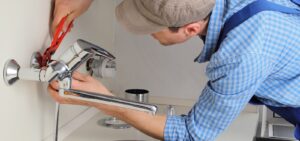▷How To Install Faucets At Residential Building In San Diego?
How To Install Faucets At Residential Building In San Diego?
Installing faucets in a residential building is a crucial step in ensuring a functional and efficient plumbing system. Whether you’re a homeowner looking to upgrade your kitchen or bathroom, or a contractor working on a new construction project, knowing how to install faucets properly is essential. In this article, we will discuss five different ways to install faucets in residential buildings to help you make an informed decision and achieve a leak-free, functional plumbing system.
Standard Deck-Mounted Installation
The most common method of faucet installation in residential buildings is the standard deck-mounted approach. In this method, the faucet is installed on the sink or countertop. It involves drilling holes in the appropriate location on the sink or countertop and securing the faucet using mounting nuts from beneath. This method is suitable for both single-handle and double-handle faucets. Ensure that the holes are the right size for the faucet you plan to install, and follow the manufacturer’s instructions for a secure installation.
Wall-Mounted Installation
Wall-mounted faucets are an elegant and space-saving option for residential bathrooms and kitchens. This installation method involves mounting the faucet on the wall above the sink or bathtub. It is important to ensure that the plumbing connections are concealed within the wall for a clean and sleek look. Wall-mounted faucets require precise measurements and proper alignment to prevent leaks and ensure they function correctly.
Single-Hole Installation
Single-hole faucets have gained popularity due to their modern and minimalist design. They require only one hole in the sink or countertop for installation, making them a convenient choice for small spaces or those looking for a clean aesthetic. To install a single-hole faucet, insert the faucet body through the hole and secure it with the provided mounting hardware. Make sure to follow the manufacturer’s instructions, and use silicone or plumber’s putty to create a watertight seal.
Center-Set Installation
Center-set faucets are a versatile option commonly used in bathrooms. They have a single spout and two handles, with all components mounted on a single base unit. Installing a center-set faucet involves drilling three holes in the sink or countertop: one for the spout and two for the handles. Ensure proper alignment and use mounting nuts and washers to secure the faucet in place. Properly connect the water supply lines to the faucet, and don’t forget to apply sealant for leak prevention.
Widespread Installation
Widespread faucets are similar to center-set faucets but offer more flexibility in terms of spacing. They consist of three separate components: the spout and two handles, allowing you to position them at a distance from each other on the sink or countertop. Widespread faucet installation involves drilling three separate holes for each component. It’s essential to maintain proper alignment and use the provided hardware for a secure installation. Connect the water supply lines and apply sealant to prevent any leaks.
FAQs
How Do I Determine The Right Faucet Size For My Sink Or Countertop?
Measure the distance between the center of the left and right holes (for center-set or widespread faucets) or the diameter of the single hole (for single-hole faucets). Match these measurements with the faucet specifications provided by the manufacturer.
What Tools Do I Need For Faucet Installation?
Common tools for faucet installation include an adjustable wrench, pliers, a screwdriver, a pipe wrench, Teflon tape, plumber’s putty or silicone sealant, and a basin wrench.
Can I Install A Wall-Mounted Faucet Myself, Or Should I Hire A Professional?
Wall-mounted faucet installation can be more complex due to concealed plumbing connections. If you have plumbing experience and the necessary tools, you can attempt it yourself. However, hiring a professional plumber is recommended for a flawless and leak-free installation, especially if you’re uncertain about the process.
Call Home Pro Plumbing at (858) 251-7070 for a free consultation if you think there may be a water leak, or use our website to contact us.
Conclusion
Home Pro Plumbing offers tools like subsurface cameras for inspecting pipelines for leaks that you can’t even see. We are experts at fixing hidden plumbing issues and we know where to look for common issues. Even better, we offer yearly safety and plumbing inspections so that we may identify potential problems before they even materialize.
Give Home Pro Plumbing a call right away to learn more about how our experts can help with leak detection in San Diego, CA.
Our Plumbing & Leak Detection Services
Related Posts

▷5 Benefits of Hydro Jet Plumbing: A Comprehensive Guide In San Diego
5 Benefits of Hydro Jet Plumbing: A Comprehensive Guide In San Diego Hydrojet plumbing is a…

▷Essential Tips for Installing a Heat Pump Water Heater In San Diego
Essential Tips for Installing a Heat Pump Water Heater In San Diego Did you know that…

